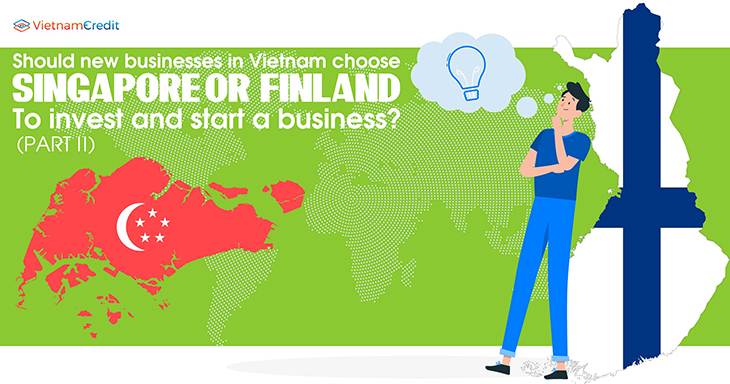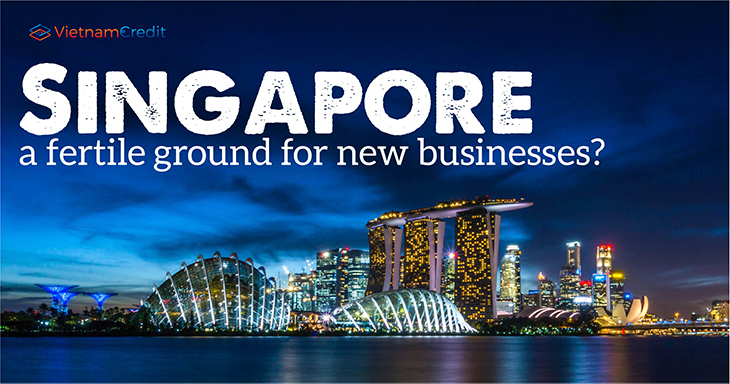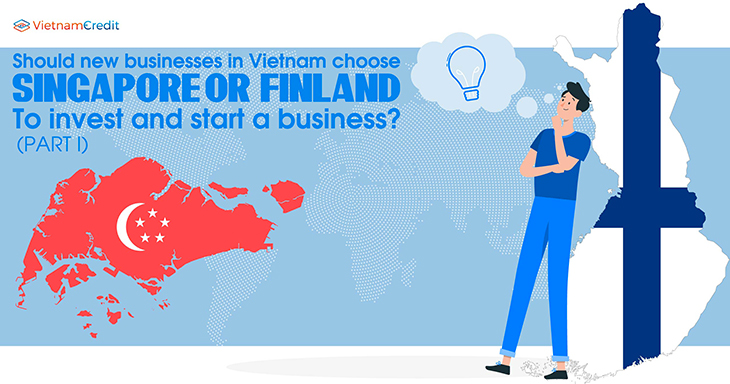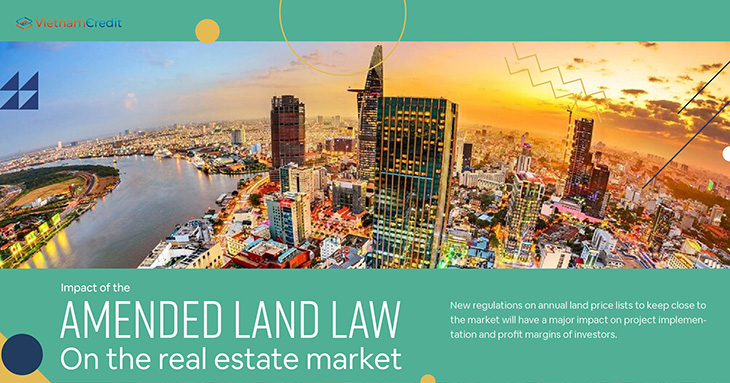Although Singapore and Finland are both developed and innovation-driven economies - the most advanced stage of an economy, there are significant differences in an entrepreneurial capacity, shown in 6 key differences.
III. Six key differences
4. Internationalization level of Early-stage businesses
The level of internationalization of early-stage businesses in GEM reports was determined by the extent of the products and services produced by a local business to be sold to foreign customers. For the comparison of Singapore and Finland in this condition, internationalization orientation was measured with a proportion of at least 25% foreign customers that businesses have. The data summary for both countries is depicted in the table below in which 27 countries in their innovation-driven stage were measured.
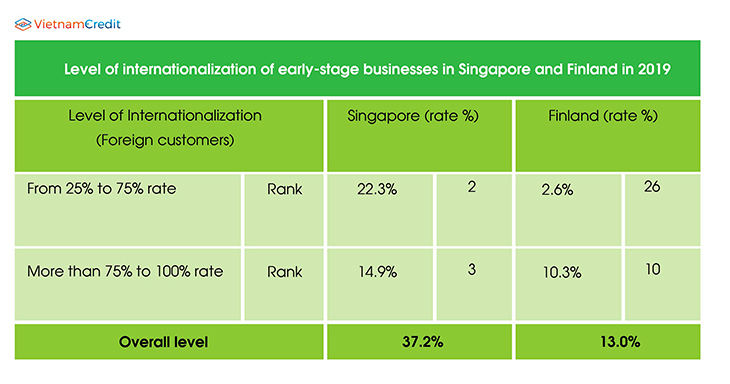
As can be seen from the table, the orientation level of early-stage businesses in Singapore is especially high among other countries in the same stage of development.
One of the main reasons for such a high rate in Singapore can be attributed to the 10th pillar of the Global Competitiveness index which is market size. The market size was traditionally restrained by national borders; however, in the era of globalization, international markets are also taken into account, especially for countries having small domestic market sizes like Singapore.
Applying to the case of Singapore and Finland, although both share the similar basic characteristics of the domestic market size, the difference in the level of internationalization is chiefly attributed to the size of the international market which can be measured in the export volume.
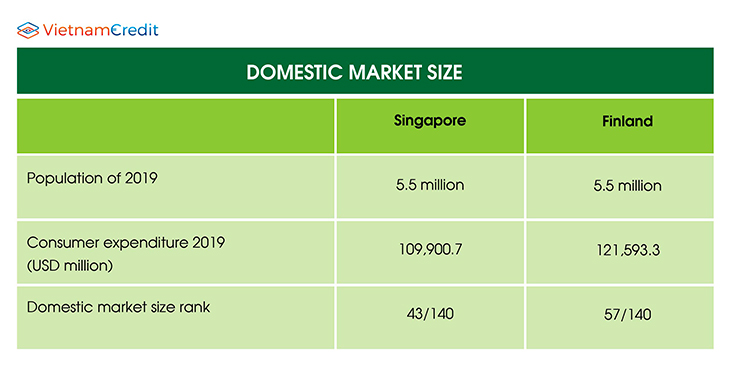
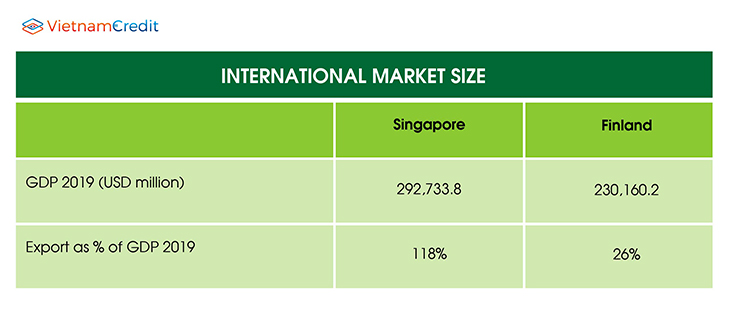
For the domestic market size, Singapore and Finland shared insignificant differences in the total population and consumer expenditure measured in 2015 as shown in the table above.
On the contrary, for the export figures, Singapore by far overtook Finland; in 2015 country’s export reached 118% of the GDP while the number for Finland was about 4.5 times lower, at 26% with the reasons explained below.
● Singapore
Singapore is one of the most trade-dependent economies with the main export product category to be machinery and electrical equipment making up 42.4% of all exports. The country’s top export destinations are China, Hong Kong, and Malaysia which are all advanced economies in the Asia-Pacific region. The exporting activity is facilitated by Singapore’s strategic location with integrated transportation infrastructure on land, air, and water.
Singapore flourished on its advantageous geographical location to become one of the world’s top transportation hubs for sea and air freight. The country is situated at the crossroads of the East-West trading routes which give access to fast-developing markets such as China and Southeast Asia. The highlights is Singapore seaports and Changi International Airport which responsible for carrying a huge amount of freight each year. The ports accommodate over 200 lines which are linked to 600 ports in 123 countries while the Changi Airport is linked to 280 cities in 60 countries.
Furthermore, Singapore’s broad trade links provide businesses with extensive market connectivity through the reduction of tariff and non-tariff barriers through free trade agreements. Agreements are established with strong economies such as the US, Japan, Australia, and China which are all top exporting destinations of Singapore.
● Finland
Finland’s trade activities can be considered high in the region however due to several recent global and economic changes caused the drop in the country’s export volume which resulted in a trade deficit. It is due to when Russia was sanctioned by NATO on trade activities with EU countries and Nokia sold its flagship business to Microsoft; those two areas previously significantly contributed to the export volume of Finland.
Since Russia is the second-largest trading partner of Finland, any trade sanctions imposed on and by Russia could easily hurt the Finnish economy which has been already suffering economic contraction during 2012-14. Actually, the economic sanctions imposed by the EU against Russia in 2014 had significant impacts on the Finnish economy. Exports to Russia roughly halved since 2014. Russian counter-sanctions banned import from EU countries also reduced the export volume of Finnish goods and products, especially in the dairy product sector.
Regarding Nokia selling flagship mobile phone operations to Microsoft, the situation adversely affected the export of information technology industries. To emphasize the extent of that impact on Finland’s economy in general and export volume in particular. By 2000, Nokia represented 4% of Finnish GDP and 21% of total exports.
With the factors analyzed above directly affecting the export volumes of Singapore and Finland which also shapes the international market size, we must acknowledge that it also affects the international orientation of the businesses. With positive conditions, entrepreneurs in Singapore would have better opportunities to reach foreign markets thus increasing the country’s level of internationalization. On the other hand, with the recent unfavorable situation, Finnish businesses are facing difficulties to expand overseas, as a result, the rate of internationalization in the country should be lower.
5. Technology utilization
According to the data shown in the GEM report of Singapore, Singapore and Finland are notably different in terms of technological application and utilization, based on the ranking of technology applied in business among innovation-driven countries globally. Singapore consistently stood in the top 3, outperformed Finland - rank 19th in terms of new technology integration.
The level of technology utilization is higher in Singapore, with a GCI score of 6.2 for Technological Readiness, compared to Finland’s score of 6.0. Explanations for the difference in the integration of technology in businesses possibly derived from education systems, national technological infrastructure, and government policies.
-
Technology in education
The perspective about the impact of technology in business can be implemented from the early stage of education. While Singapore and Finland are innovation-driven, the way each country utilizes technology in education has created a separate mindset and later influenced the use of technology in business.
Finnish students, while having access to modern and latest technological learning supports, are guided to follow a traditional method of studying. Students are taught to use their creativity and imagination more than technological visualization and model.
Finland’s education outperformed the USA’s, a technology-integrated education. Pasi Sahlberg - director general of Finland’s Centre for International Mobility and Cooperation, stated that Finnish education embodied the power of human innovation, rather than the advance of modern technology. This education has laid the early bricks of entrepreneurs’ mindset: Finnish entrepreneurs appreciate the value of ideas more than the benefit of technology in business (Invest in Finland).
On the other hand, Singaporean education aims to equip students with as much technical experience as possible, from basic computing skills to the latest invention. According to Michael Muhunthan - principal of Jurong West Secondary School in Singapore, while technology cannot replace the role of teacher, it can shorten the time needed to deliver lessons, which essentially means that more knowledge can be learned in the same duration. Singaporean entrepreneurs are proving that experiencing and making use of the latest cutting-edge technology definitely gave them an advantage in comparison to entrepreneurs from other countries, and the trend of utilizing technology in businesses has been constantly increasing from 2015 to 2019 in Singapore.
-
Government policy - The ease of gaining access to technological assets and applications
Technological Readiness - one of the twelve pillars of GCI, measures the agility of an economy in order to adapt existing technologies to improve the productivity of its industries. With a score of 6.2 in the Technological readiness pillar, Singapore actually has a better stage of technological availabilities.
As mentioned above, a reason for the low rate of adopting technology in businesses in Finland could be the result of education, as Finnish education embraces the thought process more than technology advantages. However, there is another reason for the surprisingly low rate of applying technology in Finland (16.5%), comparing to the average of European countries (21%): government policies.
Nokia, a used-to-be behemoth in telecommunication and technology in the mid 19th century, left a dent into the economy of Finland. In 2000, Nokia accounted for 4% of Finland’s GDP, and 70% of Helsinki’s stock exchange market capital. When the giant collapsed, the Finnish government was suffered from a huge shock, and the technological economy of Finland fell into “permafrost”. The Finnish government, after the decline of Nokia, strictly controlled the entering and adopting any new technology on large scale, which led to a low standard of technology readiness. The use of new, especially the latest technology in businesses, was limited severely, resulting in a lower-than-average rate of technology utilization between Finland and other European countries.
On the contrary, the Singaporean government encourages any kind of cutting-edge technology in business activities. The government spent up to 2% of GDP in 2018 to support research and development of new technologies. The number of start-ups in high-technology and knowledge-intensive sharply increased by more than 90%, from 2,800 in 2015 to 5,400 in 2019, according to Mr. Edwin Chow - Group Director (Industry & Enterprise Development) at SPRING Singapore. All the efforts from the government resulted in a high score of technology readiness of Singapore - 6.2.
From the case of Singapore and Finland, government policies proved to have a very important role in the technology readiness of the country
6. Innovation and differentiation
Singapore and Finland firms focused more on differentiating products or services to potential customers.

(Ranking of Product differentiation between Singapore and Finland)
The concentration of differentiation is similar between Singapore and Finland. However, Singaporean businesses applied a customer-centric strategy, hence, pushed the rate of differentiation to 48.8%, in comparison to 43.0% of Finland. A clear example of how Singaporean businesses focus on the customer is “Block 71”, the place dubbed by the Economist as "the world’s most tightly packed entrepreneurial ecosystem". Combining the ideas of several entrepreneurs, with financial support from the government, Timbre+ founded Block 71 and became one of the leading businesses in Food and Beverage recently. Customers were attracted to the place by both the high availability of open time and variation in options, and the service of this kind hasn’t been served anywhere else in Singapore.
❖ Immigrant Entrepreneur
A huge difference between Singapore and Finland is the composition of the population. Singapore is a multicultural country, with Chinese account for 74% as a majority. On the other hand, the Finnish population is made up of approximately 90% native.
The main reason for the higher level of innovation and differentiation in Singapore is immigrant entrepreneurs. By definition, immigrant entrepreneurs of Singapore are people coming from other countries, to Singapore and participate in business activities here. Generally, for multicultural countries like Singapore and America, immigrant entrepreneurs play an important role in the market since they contribute to the variation of products and services. There are several reasons for the fact that why immigrant entrepreneurs thrive strongly in Singapore than other regional countries.
Firstly, immigrant entrepreneurs have to face the same difficulties as small and medium enterprises. In Singapore, with financial support from the government, combined with the openness of the local market, immigrant entrepreneurs easily overcome posed obstacles. Their cultural products and services are welcome by society, giving them the opportunities to develop and maintain their businesses in Singapore. Their main sectors of businesses are retail, wholesale, and restaurant.
Secondly, the language barrier is another hindrance to immigrant entrepreneurs when they start a business in other countries. Fortunately, English is the common language in Singapore and is widely used by a majority of the population, despite their origin as Chinese, Indonesian, or Malaysian. International entrepreneurs often find it quite easy to settle in a country with English as the dominant language, and Singapore is a typical example.
Thirdly, the lack of knowledge and about practices and legislation as well as finance barriers are other difficulties in most countries posed to immigrant entrepreneurs. Fully aware of the obstacles, the Singaporean government offers a lot of supports as well as guidelines to foreign business owners. With the friendliness of the government toward business, Singapore was ranked first in terms of ease of doing business.
Finally, the last and biggest difficulties are the external business environment. The most common form is racial discrimination. Singaporean people, living in a multicultural environment from an early age, are well-known for their friendly attitudes toward foreigners.
With all the mentioned difficulties being neutralized by the Singaporean government and society, immigrant entrepreneurs have a space to develop and bloom in the country. This advantage brought Singapore a higher level of innovation and differentiation in comparison to other countries, and specifically Finland in this report. The score of the innovation pillar reflects the difference, with 5.2 and 5.7 respectively for Finland and Singapore.
Overall, Singapore showed better performance under the scope of the Global Competitiveness Index. However, each country offers a different range of characteristics, which can be suitable for either Born Global or International New Venture. International entrepreneurs, especially Vietnamese entrepreneurs should carefully consider the specifications of each country before determining to enter the foreign markets.
An Nguyen - Vietnam Credit

